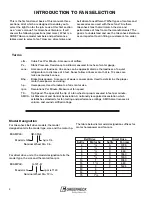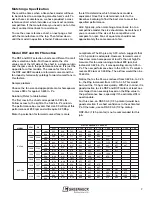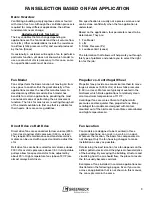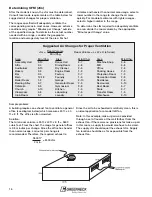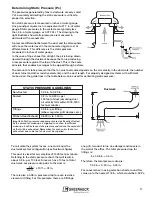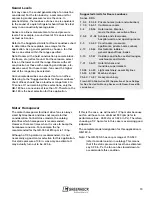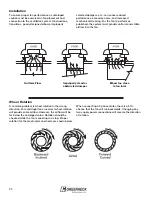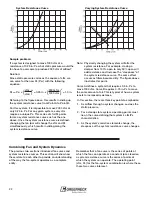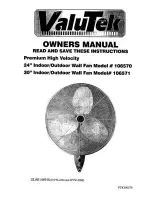
Model RSF and BCF Selection
The RSF and BCF selection charts are different from all
other selection charts. For these models, the cfm
values are at the left side of the chart in a single column
and the rpms are in the performance boxes. It is just the
opposite for other models. The reason for this is that
the RSF and BCF models are forward curved, and the
fan industry historically catalogs forward curved fans in
this fashion.
Sample problem:
Choose the fan size and appropriate motor horsepower
to move 980 cfm against 0.625 in. Ps.
Solution: (Refer to table below)
The first row in the chart corresponds to 980 cfm.
Follow across to the right to the 0.625 in. Ps column.
The performance box reveals that size 90 will meet this
performance at 893 rpm and will require 0.20 Bhp.
Motor hp selection for forward curved fans is more
complicated. The Bhp is only 0.20, which suggests that
a 1/4 hp motor is adequate. However, forward curved
fans draw more horsepower at low Ps than at high Ps.
Assume this fan was running at about 893 rpm, but
instead of 0.625 in. Ps, it was operating at only 0.25 in.
Ps. The new performance box in the 0.25 in. Ps column
reveals 894 rpm at 0.45 Bhp. The airflow would then be
1860 cfm.
Notice that as the Ps was reduced from 0.625 in. to 0.25
in., the Bhp increased from 0.20 to 0.45. This would
burn out the 1/4 hp motor quickly. With this in mind, it is
good practice to size RSF and BCF motors at least one
size larger than necessary based on the Bhp value in
the performance box, especially if the estimated Ps is
questionable.
For this case, an RSF-90-3 (1/3 hp motor) would be a
good selection if we had confidence in the estimated
Ps. Otherwise, use an RSF-90-5 (1/2 hp motor).
RSF-90-4 (1/4 hp motor) is not recommended for this
job.
Matching a Specification
There will be times when a Greenheck model will have
to be matched to a competing manufacturer’s unit. To
aid in these circumstances, we have provided a cross
reference chart which includes our nine most common
competitors. If the manufacturer you need is not on this
chart, contact Greenheck for assistance.
To use the cross reference chart, on next page, start
with the manufacturer at the top. Then follow down
until the model in question is found. Follow across to
the left to determine which Greenheck model is
equivalent. Once this is determined, refer to the
Greenheck catalog to find the best size to meet the
specified performance.
Hint: Typically, when matching a Greenheck fan to a
competitive model, the size should also be matched. If
you are unsure of the size of the competitive unit,
compare fan rpm. Fans of equal size should move
approximately the same amount of air.
0.125
0.250
0.375
0.500
0.625
0.750
1.000
1.250
1.500
1.750
RSF-90
980
1065
1200
1304
1420
1543
1640
1783
1860
2022
2080
2261
1240
1097
1780
1575
2140
1894
STATIC PRESSURE / CAPACITY
MODEL
CFM
OV
RSF-100
rpm
Bhp
rpm
Bhp
rpm
Bhp
rpm
Bhp
rpm
Bhp
rpm
Bhp
rpm
Bhp
rpm
Bhp
rpm
Bhp
521
630
725
812
893
967
0.08
0.11
0.13
0.16
0.20
0.23
593
685
771
849
925
994
1125
0.13
0.16
0.19
0.23
0.26
0.30
0.38
668
747
825
898
966
1031
1153
1267
1371
0.19
0.23
0.27
0.31
0.35
0.39
0.48
0.57
0.67
746
819
887
953
1016
1077
1191
1298
0.28
0.33
0.37
0.42
0.46
0.51
0.61
0.71
828
894
954
1014
1073
1128
1236
0.40
0.45
0.50
0.55
0.60
0.65
0.76
910
970
1027
1080
1134
0.54
0.60
0.66
0.71
0.77
476
572
656
733
807
876
0.10
0.13
0.16
0.19
0.23
0.27
605
679
748
813
873
931
1040
1143
1240
0.24
0.29
0.33
0.38
0.42
0.47
0.56
0.66
0.77
699
763
823
880
935
989
1086
1181
1269
1354
0.40
0.45
0.50
0.56
0.61
0.67
0.78
0.89
1.00
1.12
7




